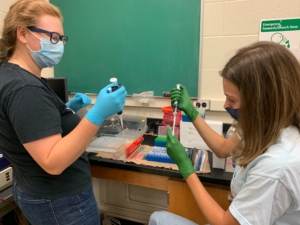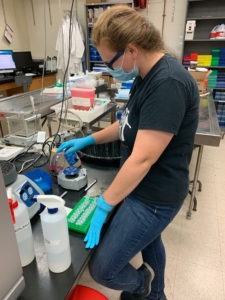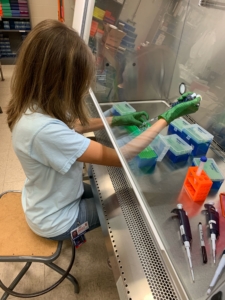 Hello readers! Although we know you come here for cute turtle pics and stories about us sloshing through marshes, unfortunately we have none of that this week. Having packed up the field lab, we have returned to the Wildlife Epi Lab headquarters to do lots of very important science. This means no more daily overdose of vitamin sunny D, no more mosquito bites, and no more smelling like muddy water. The transition from feral swamp children to indoor lab students took a little bit of adjusting. Although we knew we could always call Dr. Allender or Dr. Laura for help, we had grown accustomed to relying on each other to make the day to day decisions. Over the course of this summer the two of us have become a WEL-oiled (ha get it) machine and we’re very used to being left to our own devices. Suddenly being thrown back in the lab surrounded by resources was a little bit of a culture-shock. Now we get to enjoy the luxury of having advice right down the hall.
Hello readers! Although we know you come here for cute turtle pics and stories about us sloshing through marshes, unfortunately we have none of that this week. Having packed up the field lab, we have returned to the Wildlife Epi Lab headquarters to do lots of very important science. This means no more daily overdose of vitamin sunny D, no more mosquito bites, and no more smelling like muddy water. The transition from feral swamp children to indoor lab students took a little bit of adjusting. Although we knew we could always call Dr. Allender or Dr. Laura for help, we had grown accustomed to relying on each other to make the day to day decisions. Over the course of this summer the two of us have become a WEL-oiled (ha get it) machine and we’re very used to being left to our own devices. Suddenly being thrown back in the lab surrounded by resources was a little bit of a culture-shock. Now we get to enjoy the luxury of having advice right down the hall.
 While lab work has kept us very busy, you’ll still find us gazing longingly at ponds and wondering “how many turtles do you think are in there right now?”. We’re coping fairly well and have thrown ourselves into our work and even helped out with other projects in the lab. So what is this very important science we have been doing? It comes down to processing the samples we collected while in the field. Believe it or not we were not just taking cloacal-oral swabs (COS) for fun, we were doing so to test for various diseases. We spent several days extracting the DNA from all the COS samples and are now doing conventional PCR to identify if any of that DNA matches up with a virus the turtle might have had at the time.
While lab work has kept us very busy, you’ll still find us gazing longingly at ponds and wondering “how many turtles do you think are in there right now?”. We’re coping fairly well and have thrown ourselves into our work and even helped out with other projects in the lab. So what is this very important science we have been doing? It comes down to processing the samples we collected while in the field. Believe it or not we were not just taking cloacal-oral swabs (COS) for fun, we were doing so to test for various diseases. We spent several days extracting the DNA from all the COS samples and are now doing conventional PCR to identify if any of that DNA matches up with a virus the turtle might have had at the time.
 DNA extraction is a lot like panning for gold, except instead of a sifting pan you have tiny collection tubes, and instead of rinsing with water you use various solutions with very specific sequence. Despite Michelle’s favorite saying, “Science is more of an art than a science”, these procedures require precise protocols and exact measurements. If you are one of those people that likes to cook by eyeballing the amount of spices rather than exactly follow the recipe, this is not the place for that attitude. Thankfully pipettes exist because these protocols require exact measurements down to the quarter of a microliter. Once we have extracted all the “gold” we test its purity by using a Nanodrop machine. This tells us if we have extracted enough DNA to be useful for further procedures like conventional PCR. The fancy word for this process is spectrophotometry, but if you’re a cool kid you call it “dropping”. Because who is cooler than scientists doing quantitative analysis of DNA molecules? Literally no one.
DNA extraction is a lot like panning for gold, except instead of a sifting pan you have tiny collection tubes, and instead of rinsing with water you use various solutions with very specific sequence. Despite Michelle’s favorite saying, “Science is more of an art than a science”, these procedures require precise protocols and exact measurements. If you are one of those people that likes to cook by eyeballing the amount of spices rather than exactly follow the recipe, this is not the place for that attitude. Thankfully pipettes exist because these protocols require exact measurements down to the quarter of a microliter. Once we have extracted all the “gold” we test its purity by using a Nanodrop machine. This tells us if we have extracted enough DNA to be useful for further procedures like conventional PCR. The fancy word for this process is spectrophotometry, but if you’re a cool kid you call it “dropping”. Because who is cooler than scientists doing quantitative analysis of DNA molecules? Literally no one.
Just because we are no longer out in the swamp watching Alexis fall over a bunch, doesn’t mean we still aren’t having a lot of fun. We’ve missed our seeing our friends around the lab and getting to work with some of the awesome animals the lab has in its care. We continue to be firmly in denial that our summer is ending soon and that eventually our wonderful research fellowship will be over, so overall we are coping super well. Catch us next week catching turtles again as we go back for our Kane County encore recapturing the headstarts we released over a month ago!
